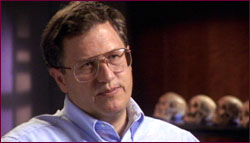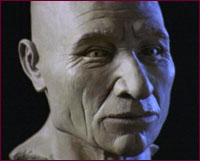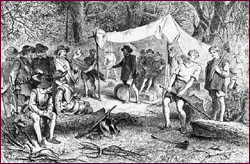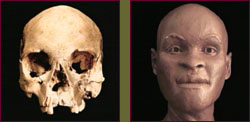
|

|
|
 Doug Owsley
Doug Owsley
|
Claims for the Remains
Douglas W. Owsley
Division Head for Physical Anthropology, National Museum of
Natural History, Smithsonian Institution
Deciding to initiate a lawsuit is rarely easy, particularly
one that sues the federal government. But, in the case of
Kennewick Man, there was no alternative.
Everything I was told about him suggested that Kennewick Man
did not have physical features characteristic of Native
Americans. I've been measuring, analyzing, and evaluating
Native American remains, particularly those from the western
half of North America, for the 25 years of my professional
career. The database I've developed in that time with Dr.
Richard Jantz of
the University of Tennessee is comprehensive and detailed. Our
cranial measurements allow us to trace population movements
and draw conclusions about tribal affiliation. Kennewick Man's
description didn't fit any group I knew of. My requests to
study the skeleton (to the Army Corps of Engineers and to the
Umatilla tribe to whom the Corps had assigned the remains)
went unanswered; the skeleton was to be returned and likely
reburied in less than a few weeks. In order to learn,
scientifically, who Kennewick Man was, immediate intervention
was necessary.
Kennewick Man has been dated to about 9,000 years ago. Few
securely dated, well-preserved Paleo-American skeletons have
been discovered. Some of them have been reburied, notably a
10,675-year-old female found near Buhl, Idaho and an
8,000-year-old skeleton found in Hourglass Cave in the
Colorado Rockies. Neither was adequately studied by
scientists. Yet, there's nothing in the NAGPRA regulations that prevents study. [NAGPRA is the Native American
Graves Protection and Repatriation Act, under which tribes may
file claims to remains if they can show a cultural affiliation
to them.] To keep Kennewick Man above ground until some of the
unresolved issues brought about by ambiguous NAGPRA terms and
restrictive interpretations of them could be addressed, we
sued.
 Nothing in the NAGPRA regulations, Owsley says,
prevents scientific study of early Americans such as
Kennewick Man.
Nothing in the NAGPRA regulations, Owsley says,
prevents scientific study of early Americans such as
Kennewick Man.
|
|
What do we hope to learn from Kennewick Man? That's not easy
to answer until many scientists from different backgrounds
have a chance to examine him. It's remarkable how much can be
learned from a skeleton; bones can tell us a great deal about
a person's life. I'm reminded of the Ice Man, found in an
Italian glacier and only half as old as Kennewick Man. His
story is of great pride and interest not only to the people in
the region where he was found, but also internationally.
Information gained through the multidisciplinary study of him
has greatly enhanced our understanding of this ancient culture
and people of Europe. For example, scientists noted puncture
marks in his leg and ankle and referred to them as "tattoos."
Another scientist, noting the location of the tattoos,
correlated them with acupuncture points. So now, instead of a
single individual with body markings, we have indications of a
different behavior.
That kind of building upon bits of basic data is what science
is all about. The more scientists who are able to examine a
skeleton, the more likely we are to arrive at the truth. Even
now, the few scientists who have seen Kennewick Man disagree
on whether he had three broken ribs or six, whether his right
arm was broken or his left elbow, whether the stone point in
his hip hastened his death or was fully healed over when he
died.
|
 Owsley discovered that five skeletons unearthed at
Jamestown Colony are not Native American as originally
supposed, but African. This exemplifies why scientists
should be able to thoroughly study early skeletal
remains, he says.
Owsley discovered that five skeletons unearthed at
Jamestown Colony are not Native American as originally
supposed, but African. This exemplifies why scientists
should be able to thoroughly study early skeletal
remains, he says.
|
That's why I believe that Kennewick Man should be available
for further study. We can easily miss what we aren't looking
for. It takes all of us, coming from our different
perspectives and using our various expertise to learn
everything we can from a skeleton and to resolve the
differences we find. We are now able to learn much more than
scientists could a generation ago; our techniques are better,
our technology more sophisticated. For example, using current
databases, I was able to determine that five skeletons
unearthed at Jamestown Colony are not Native American as they
were identified in the 1950's; they are African. Historic
documents confirm their presence in Jamestown colony, but the
record is limited. Valuable evidence of Black History would
have been lost if the remains had been given to local tribes
for burial. In the same way, scientists in the future will be
able to learn much more than we now can. Furthermore, they
will have new questions because scientific interests evolve
and theoretical paradigms shift.
 Owsley fears that if scientists in this country find
they are legally unable to study ancient skeletons,
the study of early peoples in North America may
suffer, while investigations of ancient people in
other parts of the world—including South
America, where Luzia (above) was found - will proceed
apace.
Owsley fears that if scientists in this country find
they are legally unable to study ancient skeletons,
the study of early peoples in North America may
suffer, while investigations of ancient people in
other parts of the world—including South
America, where Luzia (above) was found - will proceed
apace.
|
|
But this case is much larger than Kennewick Man and the
plaintiff scientists who have asked to study him. Other old
skeletons have been found and new discoveries of old bones
will occur. If Kennewick Man had been reburied without study,
and if other ancient skeletons and future discoveries follow
him into the ground, I'm afraid the field of American physical
anthropology that studies ancient populations will slowly die.
New researchers, seeing only restricted areas of investigation
here, are likely to turn their attention to other countries.
In the future, then, we may learn a great deal about ancient
migration patterns and populations in South America, Asia,
Africa, and Europe, but North America may become a question
mark—an unknowable area that leaves a great gap in the
total picture.
As a scientist, I care intensely about each of these issues.
But personally, the whole subject is much closer to my heart
than that. I've lived my whole life with a deep interest in
the prehistoric peoples of North America. I want their story
to be told completely and accurately. Unless we study
Kennewick Man, the story of the native peoples, the story of
America, and the story of his people will forever be unclear
and inaccurate.
Does Race Exist? |
Meet Kennewick Man
Claims for the Remains
|
The Dating Game
| Resources
Transcript
| Site Map |
Mystery of the First Americans Home
Editor's Picks
|
Previous Sites
|
Join Us/E-mail
|
TV/Web Schedule
About NOVA |
Teachers |
Site Map |
Shop |
Jobs |
Search |
To print
PBS Online |
NOVA Online |
WGBH
©
| Updated November 2000
|
|
|


 Doug Owsley
Doug Owsley
 Nothing in the NAGPRA regulations, Owsley says,
prevents scientific study of early Americans such as
Kennewick Man.
Nothing in the NAGPRA regulations, Owsley says,
prevents scientific study of early Americans such as
Kennewick Man.
 Owsley discovered that five skeletons unearthed at
Jamestown Colony are not Native American as originally
supposed, but African. This exemplifies why scientists
should be able to thoroughly study early skeletal
remains, he says.
Owsley discovered that five skeletons unearthed at
Jamestown Colony are not Native American as originally
supposed, but African. This exemplifies why scientists
should be able to thoroughly study early skeletal
remains, he says.
 Owsley fears that if scientists in this country find
they are legally unable to study ancient skeletons,
the study of early peoples in North America may
suffer, while investigations of ancient people in
other parts of the world—including South
America, where Luzia (above) was found - will proceed
apace.
Owsley fears that if scientists in this country find
they are legally unable to study ancient skeletons,
the study of early peoples in North America may
suffer, while investigations of ancient people in
other parts of the world—including South
America, where Luzia (above) was found - will proceed
apace.